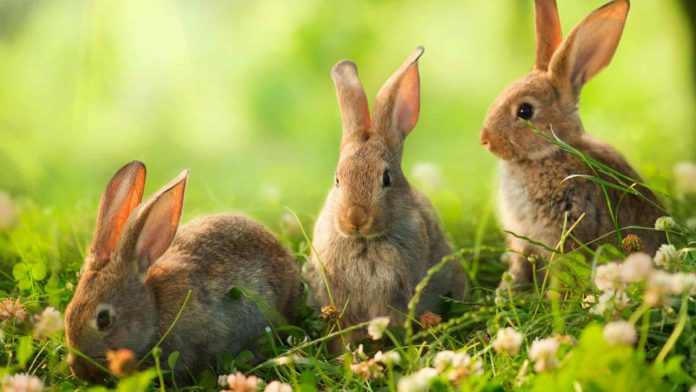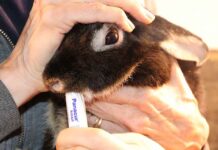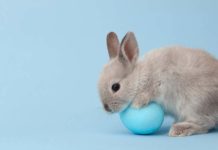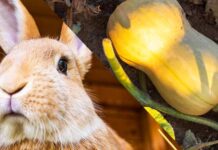Feeding a rabbit is fairly simple, but there are a few important rules you need to follow. To be healthy a rabbit needs large quantities of hay or growing grass. Rabbits also do well on additional quantities of fresh vegetables or green plants and limited amounts of dry rabbit food that you can buy from a pet store. Not all plants and vegetables are safe or suitable for rabbits. We’ll look at which types of vegetables you can offer. And at how much proprietary rabbit food you need to buy for your bunny.
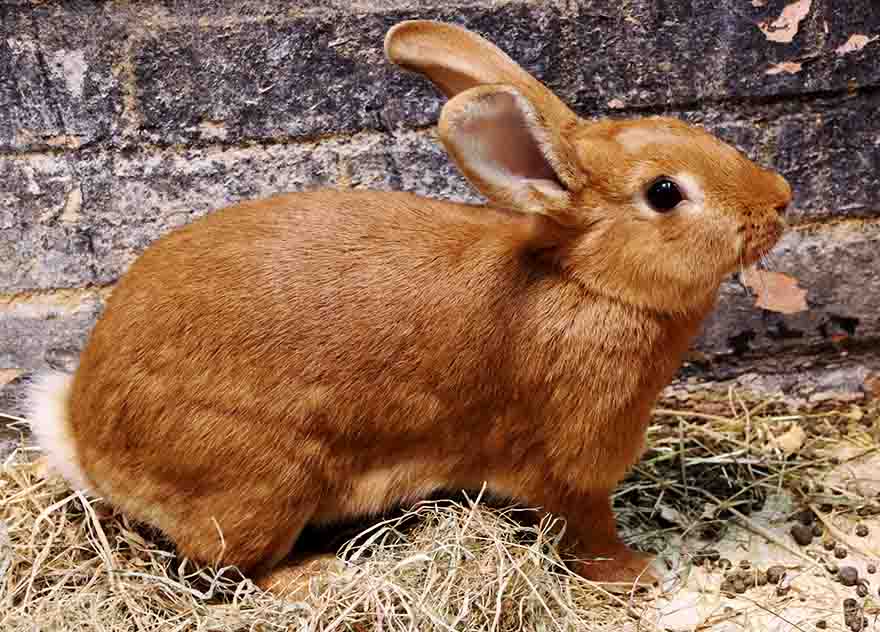
- Hay for rabbits
- Vegetables for rabbits
- Herbs for rabbits
- My rabbit won’t eat hay
- Rabbit pellets vs mix
- Bunny feeding schedule and routine
- What do rabbits drink?
Many dog and cat owners are used to opening a packet of dried food and pouring it into a pet bowl. And many people expect to be able to do this for their rabbits too. Rabbit digestive systems are rather different and the “open a packet and pour” method doesn’t work so well for them. But don’t worry, rabbits are easy to feed once you get past that misconception, and cheaper to feed once you move away from (expensive) dried food.
Rules to Avoid Rabbit Diarrhoea
Rabbits are herbivores. Think of your rabbit as a strict vegan, and never give your rabbit any meat or dairy products of any kind, they will make your rabbit ill. Diarrhoea can be very dangerous to rabbits, so it’s important to follow four simple rules that avoid upset tummies.
- Vegan all the way – think dark green leaves
- Make changes in food gradually
- Feed predominantly hay, especially when the rabbit is stressed
- Stick to a few safe vegetables until your knowledge expands
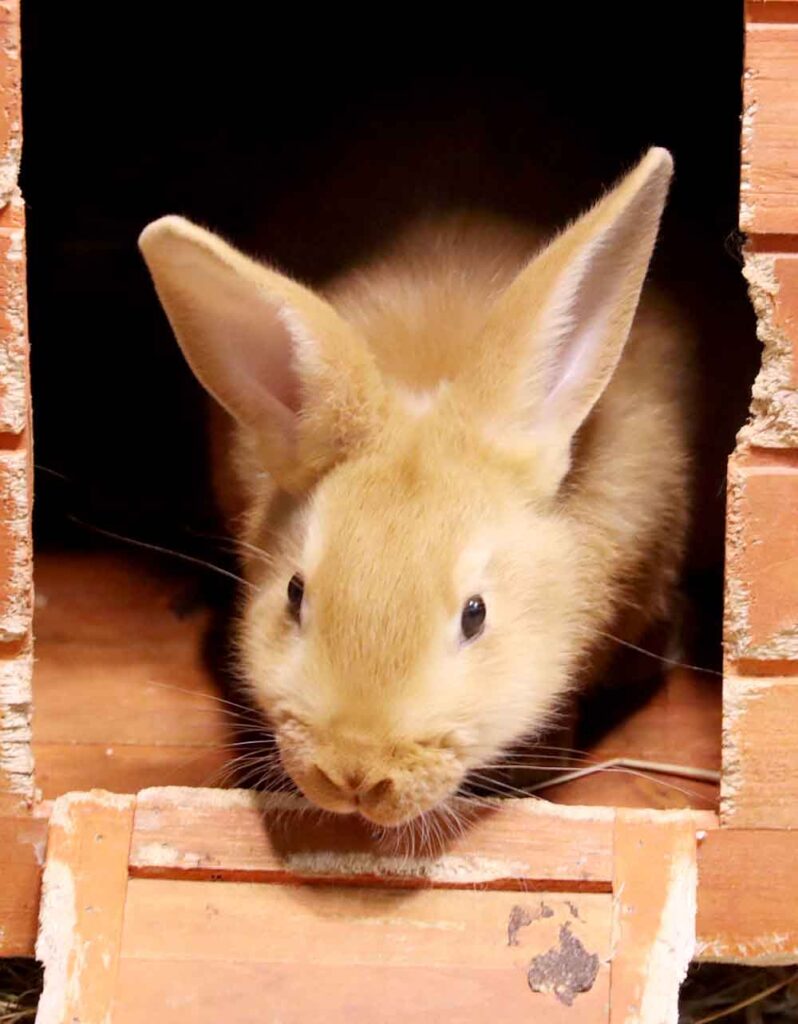
Change Rabbit Food Gradually
When you first bring your rabbit home, feeding is very easy. For the first 48 hours, just give your rabbit lots of nice fresh hay, and a little of whatever dry food they were being fed on previously. We’ll look at exactly how much dry food to give in a moment.
After hay, fresh greens should be the biggest part of your rabbit’s diet. But these must be introduced gradually as if your rabbit isn’t used to them, too much can cause diarrhorea. I know you are in a hurry to share all those lovely vegetable peelings that you have been throwing away, but take your time.
Feed Mainly Hay or Growing Grass to Rabbits
Hay should comprise the majority of your rabbit’s diet. The exception would be if you are able to graze your rabbits on pasture. As most people keep their rabbits indoors, it’s hay that they need. And hay needs to be at least 80% of an indoor or caged rabbit’s diet.
Before you rush for the mower, you can’t substitute pastured grazing with grass clippings. When you sever a blade of grass from the growing roots it starts to break down and ferment. A handful of freshly pulled grass is okay, but grass clippings in any quantity are harmful to rabbits.
If you have a lawn or other area of growing grass in your yard or garden, you can buy a secure outdoor run where your rabbits can spend part of their day. Introduce rabbits to growing grass very slowly. Just five minutes grazing the first day, to accustom their digestion to the new food and avoid diarrhoea.
After hay (or grass), your rabbit’s next source of food will be green vegetables or leaves. You don’t have to spend hours in the wilderness collecting food for your rabbit. The peelings from many of your own veggies, and veggies that are easily available in your local store, are fine.
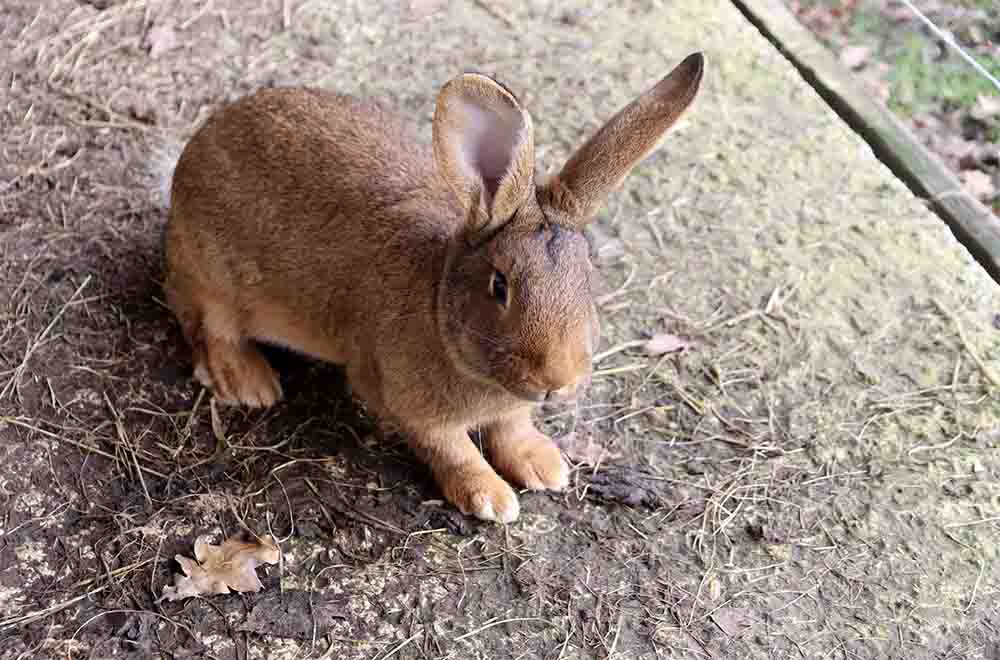
Feeding Vegetables To Rabbits
Introduce one safe veggie at a time. When you bring a new rabbit home, I suggest you give a piece of cabbage or bok choy leaf, not much bigger than your thumbnail, or at most 1 X 1 inch, on day 1. Increase the quantities each day, over the next week.
On day 2 add a thumbnail size piece of the second veggie, and increase in the same way. Here are a few safe veggies to start you off. We’ll give you a bigger list below
Safe Veggies for Rabbits
Some plants are toxic to rabbits and some, such as iceberg lettuce can cause diarrhoea. But you can share the following basic green veg that many of us have in our kitchens, with your rabbit
- Cabbage
- Broccoli leaves
- Bok choy
With greens, focus on the leaves rather than the stalks. A little bit of stalk is okay, but in general, the stalks are better off going in your compost heap than into your bunny where they can cause excessive wind.
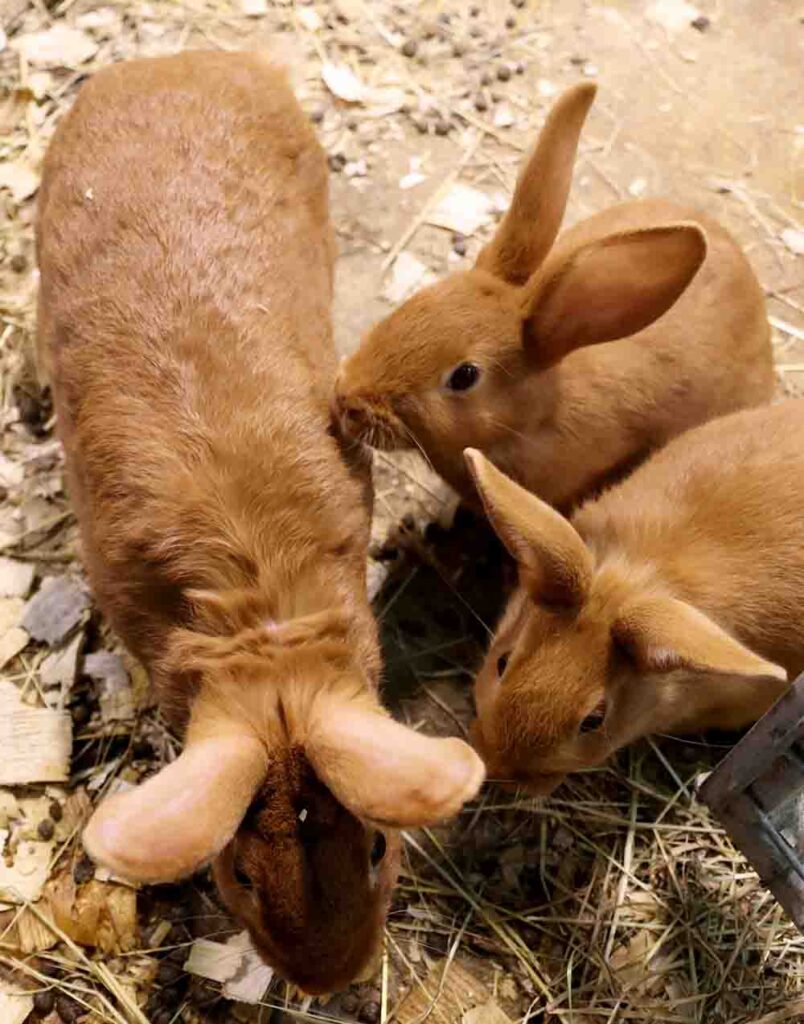
Root Vegetables for Rabbits
You can also feed small quantities of some root vegetables such as carrots and parsnips, as treats. They are very sweet and more of a treat than a necessity, so not too much of these unless your rabbit needs to put on weight.
Herbs For Rabbits
Rabbits can also eat some common herbs and leaves such as
- Basil
- Raspberry leaves
- Dandelion leaves
- Mint
And if you have trees or shrubs in your yard, some of those are suitable for rabbits too, for example
- Apple
- Birch
- Rose
- Willow
Remember, many common plants are not safe, so do your research. And while you are finding out about all the different foods that rabbits need, and getting to know your new rabbit, remember the mainstay of your rabbits diet will be hay. Let’s take a closer look at just how important hay is to your rabbit.
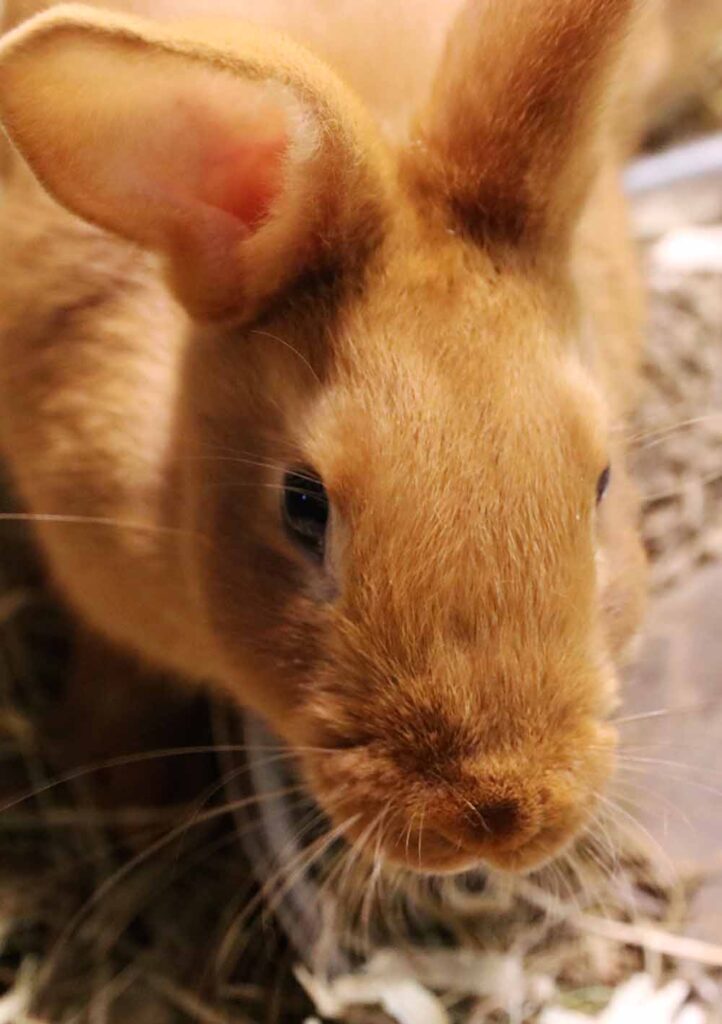
The Importance of Hay for Rabbits
Did you know that rabbits can actually survive and thrive on good quality hay alone? Good hay contains everything a rabbit needs in terms of nutrients but also has two other important roles. Hay helps to keep your rabbits teeth and intestinal tract in good working order. Let’s take the teeth part first
Hay for Rabbits Teeth
Unlike human teeth, rabbit teeth grow continuously. This is to enable them to constantly eat vegetation which would otherwise wear their teeth down into little stumps!
The downside is, that if a rabbit does not have access to the grinding action of eating fibrous food, there’s a risk that their teeth will grow too long. This will cause them problems that require expensive veterinary treatment.
Access to a plentiful supply of hay, as a major part of their diet, ensures that your rabbit’s teeth are kept nice and trim!
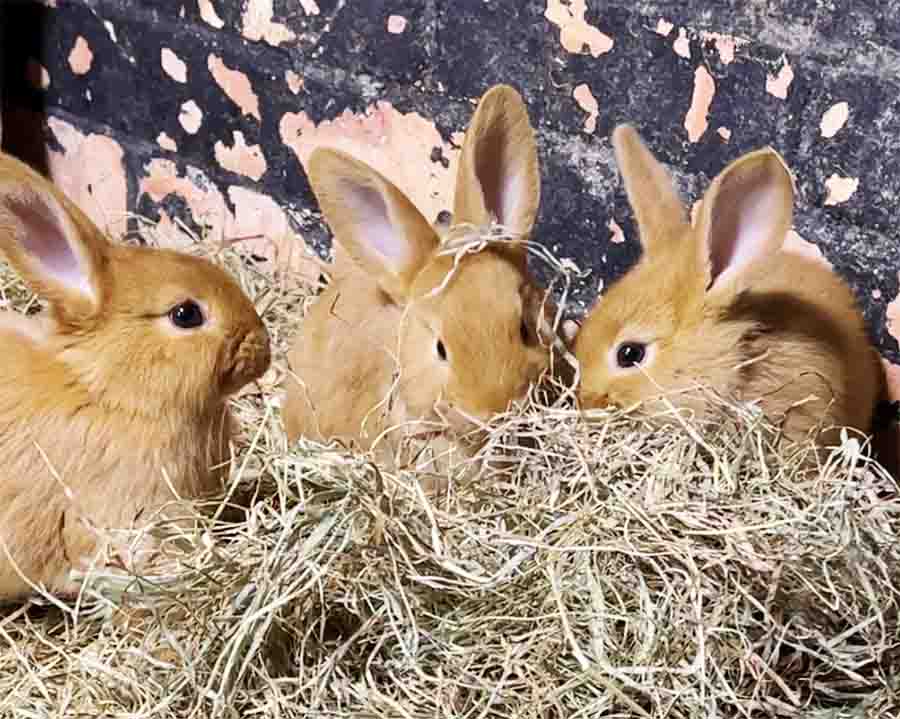
Hay For Rabbit’s Gut Health
Just as the rabbit’s teeth are adapted to eating fibrous material, so is their gut. The rabbit’s digestive tract is designed to digest large quantities of cellulose – that’s the tough fibre found in grass, hay and some other plant material.
The rabbit’s gut flora – the microscopic organisms that live there – are closely linked to their general well being. And disruptions to the gut flora can make a rabbit very sick. That means you need to keep the hay coming!
Constant Hay Supply
Rabbits need to eat pretty much continuously. If you are used to keeping carnivorous pets like cats and dogs, you are probably familiar with feeding at intervals with long gaps in between. Or with starving a pet for a few hours if they have an upset stomach, just to allow their gut to recover. It’s important to treat your rabbit very differently.
With rabbits, removing food for a few hours can be dangerous. Their whole system is designed to have fibrous material constantly moving through it. And hay is a vital part of that process.
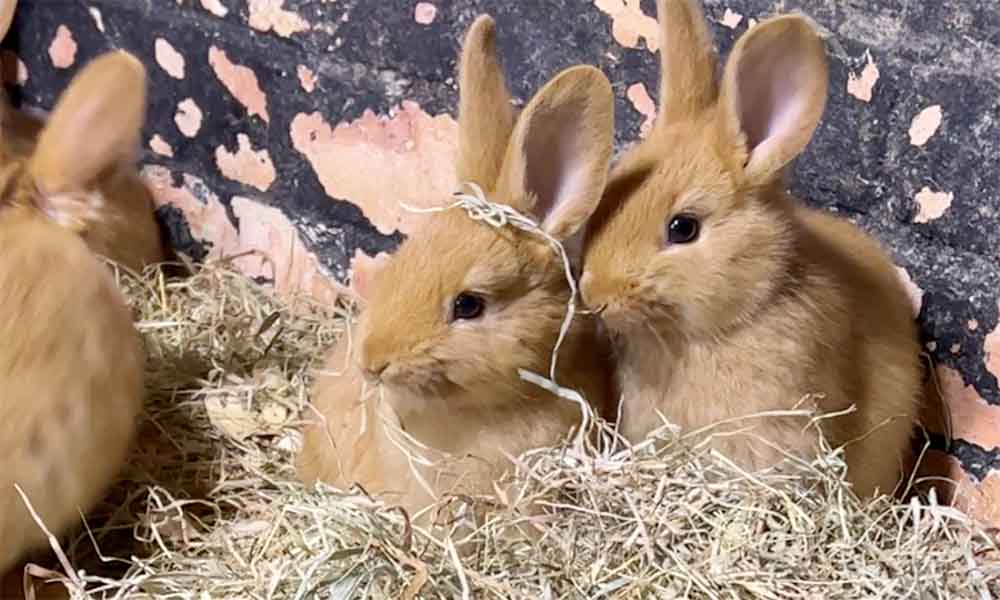
How Much Hay Do Rabbits Eat?
It’s clear that rabbits need to eat hay, and plenty of it. Many experts recommend that hay makes up at least three quarters of the rabbits total food intake each day. A good rule of thumb is that the bundle of hay you provide, should be a similar size to the rabbit.
But what if no-one seems to have mentioned this important fact to your rabbit! What if your rabbit won’t eat hay at all?
My Rabbit Won’t Eat Hay
A rabbit may refuse to eat hay for a number of reasons, including habit, and over provision of alternatives.
We all know that a plate full of healthy steamed vegetables, or a nice colourful mixed salad, is better for us than bread or candy. But when faced with a nice fresh bagel, or a tray full of cup cakes, then it’s easy to be tempted to make the less healthy choice. Rabbits are just as susceptible to temptation as we are. And a bowl full of tasty rabbit mix or pellets is simply easier and more appealing than hay to many bunnies.
If your bunny won’t eat hay, then it’s quite likely you are feeding too much food in the form of easy to eat pellets. Try cutting back on pellets a little, to encourage your rabbits to snack on their hay. This may not work unless you make an effort to make the hay more appealing. The main way to do that is to offer nice fresh hay each day.
Rabbits Need Fresh Hay Daily
Another common reason for refusing hay is that the hay on offer is stale or not very appealing. Hay comes in different types. Hay sold online for rabbits and guinea pigs is often ‘meadow hay’. The best hay for rabbits is Timothy hay, which may be a little more expensive. If you offer different types of hay, you should find which your rabbit prefers
Hay left on the floor of a hutch for a few days may become unpalatable. It’s okay as bedding but some rabbits may refuse to eat it. A better idea is to set up a hay rack of some kind, and fill it with fresh hay each morning. Then in the evening, put what is uneaten from the rack into the rabbit’s bed, and refill the rack with more fresh hay.
This helps to provide added interest for the rabbit, and may make them more enthusiastic about the whole idea.
Add Vegetables to the Hay
Another trick is to add a few little pieces of vegetable matter into the hay rack. A dandelion leaf, a bit of carrot peel, etc. That should encourage the rabbit to burrow about in their hay and hopefully snack on some as they go.
Okay, last of all, let’s move on to that dried food that you pour from a packet or sack. We’ll talk about what type and how much to feed your rabbit
Rabbit Pellets vs Rabbit Muesli
Many rabbits are fed on a muesli type mix of cereals and legumes. This is fine in the sense that the mix provides a balanced diet. But, and it’s a big but, I’ve yet to meet a rabbit that ate all the components of the muesli. They pick out the bits they like best and leave the rest. Which of course unbalances the nutrients they are getting.
Pellets avoid this problem, but they are expensive. However part of the reason that people find rabbits expensive to feed, is that they are reversing the pellet to hay ratio we’ve been talking about, and feeding too large a quantity of pellets, and too small a quantity of hay
Feeding Rabbit Pellets
This is a standard 5 inch rabbit bowl and many people start by filling a bowl like this and giving it to their rabbit. Many experts now believe this is too much, and restrict rabbits to three or four ounces of pellets per day. That’s less than half this bowl full. About half a cup (see below)
Rabbit Feeding Schedule and Timings
Rabbits prefer to eat the food you provide early in the morning, in the evening, and during the night. They then like to rest up and eat more sparingly during the day .
I provide a lot of fresh hay and some vegetable each evening. And in the morning, lots of vegetables and their ration of half a cup of pellets each
Pasture Fed Rabbits
If you are putting your rabbit out to graze for a few hours each day, then they will enjoy their grazing more in the morning and evening.
If you leave them out all day, make sure that they have somewhere dry and sheltered to get away from wind, sun and rain.
Pasture fed rabbits or rabbits grazing outdoors also need to be protected from predators and from local rabbit diseases. Ask your veterinarian about the appropriate vaccinations in your area.
Herbs for Rabbits
- Cilantro
- Parsley
- Celery
- Cucumber
- Chicory
- Zuccini
- Rocket
- Spinach
- Watercress
- Spring Greens
- Carrot tops
Trees / shrubs For Rabbits
- Sycamore
- Ash
- Hazel
- Pear
- Blackcurrant
- Aspen
- Blackberry
- Hawthorn
There are a lot of plants that are toxic to rabbits, so if in doubt, don’t feed it to them. Here are some useful resources
- Plants toxic to rabbits USA – FirstVets
- Plants toxic to rabbits UK – Rabbit Welfare Association
Water For Rabbits
Another important factor in keeping your rabbit’s gut healthy is water. Rabbits can easily get dehydrated. Never let their water bottle be empty, and check that the water comes out fairly easily, or the rabbit may limit how much they drink.
A rabbit that has been raised on water in a trough may resist drinking enough from a bottle, so if necessary provide an additional clean bowl of water each day.
Rabbit needs have been rather misunderstood over the years. If you remember that your rabbit is a leaf eater and focus on hay rather than dried food from a box as their staple diet, with some nice fresh veg added in, you won’t go far wrong.
Does your rabbit have a favorite vegetable? Let us know in the comments below!
References
The effect of four different feeding regimes on rabbit behavior

